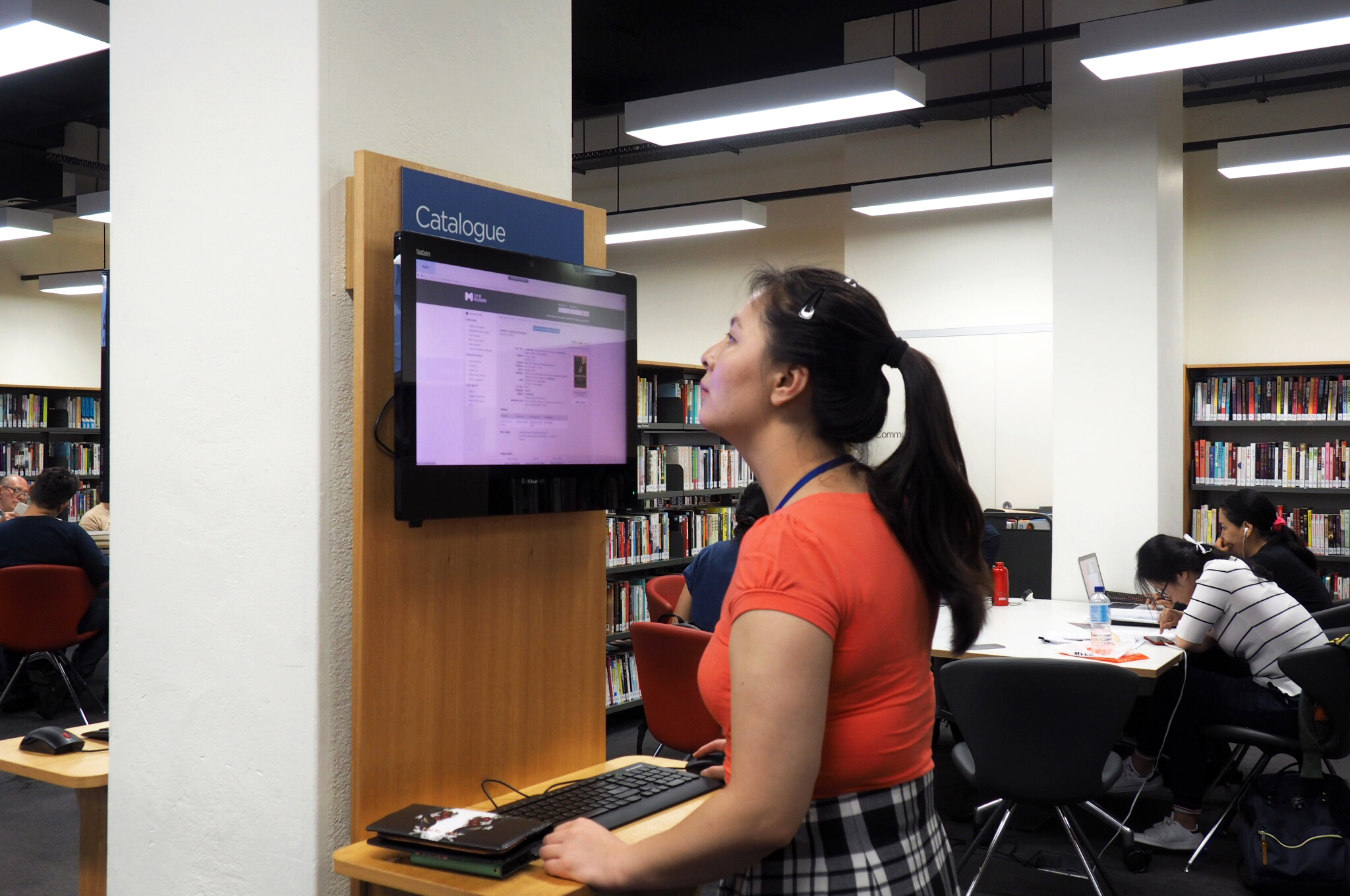Issue 101
Term 2 2017
Library catalogues and the World Wide Web: it takes two to tango
Nicole Richardson explores the way library catalogues engage with the World Wide Web to create a rich, interactive search experience.

Library catalogues have traditionally been the access point between the library user and the collection. Broadly speaking, the general function of the library catalogue is to allow the user to successfully find, identify, select and obtain resources (Tillett 2004). While these are still the main functions of the library catalogue, suggesting that these are its only functions is to suggest that libraries are used only to store information.
Through enhanced content, the online catalogue can now reflect the physical library environment, shifting into a more open, collaborative and social space reminiscent of features of Web 2.0: it can become a community hub (Gisolfi 2015; Tarulli 2012). Although the notion of enhanced catalogue content is not new, studies have questioned whether content-enriched data is used to its full potential by library users, despite being an important part of ensuring library catalogues remain relevant (Tosaka & Weng 2011, p 425).
And yet the value of libraries in the digital age is still challenged; libraries are often referred to in comparison to the wider internet. This article examines ways in which library catalogues can coexist, not compete, with the World Wide Web. Using the SCIS catalogue as an example, it discusses ways libraries can incorporate elements of the World Wide Web within their catalogues.
One-stop catalogue
Before using the library catalogue, people often seek information from Google or websites such as Amazon or Goodreads to assist with their selection (Tarulli 2012). Enhanced catalogue content can limit the need for users to visit Google before accessing the library catalogue, thus increasing the ability of the library catalogue to aid in the selection of a resource. Bibliographic metadata assists with resource selection — it is important, for instance, to know if a book is 800 pages long or what subject headings have been assigned to a particular resource — but the expectations of today’s library users go beyond this.
Let’s look at the SCIS catalogue as an example. Say you’re interested in purchasing a book for your library collection, perhaps at a student’s recommendation. You can head straight to the SCIS catalogue, bypassing Google as your source of information, and you’ll find a range of information to aid in your selection: summaries, author notes, awards and published reviews provided by Syndetics, as well as user reviews, user tags, other editions and similar books provided by LibraryThing. In addition to using the SCIS catalogue as a place to download catalogue records, it’s also an ideal selection aid that can eliminate another step in your selection process, and point you in the direction of resources that other school libraries are using.
While these services can be supplied by external platforms, library management systems (LMSs) can include features such as user-generated reviews, user tagging and reading lists, making the catalogue a rich, single location.
User-generated content
Welcoming the collaborative nature of Web 2.0 into the catalogue can help to create conversation between library users. User tags, reviews and reading lists are popular features available within some LMSs, allowing users to benefit from and contribute to shared data.
Although user tags are not quality controlled, they can add depth to records by providing information that cannot be supplied by authorised subject headings. For example, in the SCIS record (1688987) for Virginia Woolf’s Mrs Dalloway, user-generated tags such as ‘classics’ and ‘stream of consciousness’ provide a sense of the book’s tone, which is useful information for browsers. Giving catalogue users the ability to add tags to resources can benefit catalogue users; however, ‘without the ability to search and sort by authorities, enabling users to search or choose by categories such as series, names and topics, a social catalogue with its faceted navigation feature would be lacklustre at best’ (Tarulli 2012).
Another option provided by some library systems is the ability to create reading lists within LMSs. According to an earlier study by OCLC (2010), user-generated lists have proven to be popular despite the interaction not being embedded in the metadata. Whether they are created by the library staff or by the users themselves, this function allows for the possibility of ‘bibliographic playlists’ of curated resources that can support particular personal, educational or research needs (Chambers 2013). This can be done by library staff as an online library display for upcoming events such as Book Week, or by users themselves to curate their own reading lists.
The benefit of the interactive catalogue space is not only for its users; the data trail left by user tagging, reviews and indeed the use of the catalogue itself, illustrates how users interact with resources — which means that libraries can ‘more effectively rank, relate and recommend’ (Chambers 2013, p 184). It provides more meaningful information that can be used to further improve library collections and services.
Rather than relying on only the information the resource provides, user-generated content adds further depth to catalogue records. It also means that catalogue users benefit from ‘all of the accumulated knowledge’ of a school (Bento & Silva 2013, p 3). With this in mind, we are excited about the forthcoming ‘next-gen’ SCIS website that will allow members of the SCIS community to contribute to and benefit from user-generated content.
Although there remains a perception of competition between libraries and the wider internet as sources of information, the two are not mutually exclusive: when it comes to serving the needs of information consumers, it takes two to tango.
Websites and digital content
Another way to enhance the content within library management systems is to welcome websites and apps into the catalogue itself. But why do this when Google provides abundant access to the same resources?
For schools with limited budgets, including catalogue records for free digital content is a cost-effective way to enlarge and enrich their collection.
How many of your students choose the first website returned in a Google search? The quest for information should not be limited to websites that generate the most traffic through increased search engine optimisation (Bothmann & Clink 2015, p 162). As Kay Oddone (2016) notes, the website martinlutherking.org appears in the top Google search results for ‘Martin Luther King’; however, this website, hosted by white supremacist organisation Stormfront, seeks to discredit King. Catalogues, in contrast, provide access to resources that have been ‘assessed, evaluated and validated by experts’ (Bothmann & Clink 2015, p 162), giving libraries a higher degree of trust than unmoderated search engines.
Say a student is interested in finding Anzac resources, and searches for content using ‘Anzac’ as a keyword search. Google returns close to 15 million results. A search on the SCIS catalogue returns a manageable 1,100 results — resources that have been hand-picked by SCIS cataloguers for their suitability to the education community, and described using SCIS subject headings. If you further refine your search by selecting ‘add filter: Electronic resources’, and sorting by the most recent publication date, you will find a number of up-to-date, credible and educational resources — many of which are available online for free.
The benefits of websites and apps in library catalogues go beyond supplementing budget-stretched collections and increasing information literacy; they complement existing collections. They allow for a different kind of information to be made available, constructing a search environment that has not been ‘vetted only by commercial publishing establishments’ (Bothmann & Clink 2015, p 178). This, Bothmann and Clink argue, provides a ‘richer universe of recorded knowledge’. As an example, look at the interactive experience provided by resources such as My Grandmother’s Lingo (SCIS no 1784795), a free SBS-produced website seeking to raise awareness of and preserve Indigenous Australian languages. Including rich content like this within your library catalogue will lead students to unique learning experiences that may not have been accessible through traditional library catalogues (Bothmann & Clink 2015, p 161).
By making frequent use of SCIS’s digital collections, you can download bulk catalogue records for digital content to include in your own library catalogue. For more information on how to download Special Order Files, please revisit 'What’s so special about Special Order Files?' in Connections 97.
What next?
Laurel Tarulli (2012) suggests library staff research what is available: check out what other library catalogues offer, what vendors are offering — and what yours already offers. Read articles to find the success stories, but also access community-based sites such as blogs and forums to see any issues that have been encountered by people in similar situations, and any information that can provide advice. Lastly, Tarulli suggests talking to other professionals. There is a wealth of professional networking options available for school library staff, such as social media and school library listservs.
Library catalogues, like physical library spaces, can be adapted to become a one-stop community hub. Enhanced catalogue content supplied by third-party providers or your library users can help to enrich the catalogue search and browse experience. Although there remains a perception of competition between libraries and the wider internet as sources of information, the two are not mutually exclusive: when it comes to serving the needs of information consumers, it takes two to tango.
Image credits:
- Photo by Nicole Richardson.
References
- Bates J & Rowley J 2011, Social reproduction and exclusion in subject indexing, Journal of Documentation, 67(3), 431–48
- Bento FM & Silva L 2013, Going beyond the bibliographic catalog: the basis for a new participatory scientific information discovery and sharing model, in J Tramullas & P Garrido (eds), Library automation and OPAC 2.0: information access and services in the 2.0 landscape, IGI Global, Hershey, PA, 1–38
- Bothmann RL & Clink K 2015, ‘Free puppies’: integrating web resources into online catalogs, Librarianship in Times of Crisis, 159–81
- Chambers S 2013, Catalogue 2.0: the future of the library catalogue, Facet Publishing, London
- Gisolfi P 2015, New trends that define the 21st-century library, Advances in Library Administration and Organization, 173–95
- Oddone K 2016, Information and critical literacy on the web, Connections, 96, 1–3
- Petrucciani A 2015, Quality of library catalogs and value of good catalogs, Cataloguing and Classification Quarterly, 53(3–4), 303–11
- Pecoski J, Spiteri LF & Tarulli L 2014, OPACS, users, and readers’ advisory: exploring the implications of user-generated content for readers’ advisory in Canadian public libraries, Cataloguing and Classification Quarterly, 52(4), 431–543
- Spiteri, L & Tarulli, L 2011, The public library catalogue as a social space: a case study of social discovery systems in two Canadian public libraries, OCLC, accessed 30 May 2016, http://www.oclc.org/research/grants/reports/2010/spiteri2010.pdf
- Tarulli L 2012, The library catalogue as social space: promoting patron driven collections, online communities, and enhanced reference and readers’ services, ABC-CLIO, California
- Tillett B 2004, Function requirements for bibliographic records, Library of Congress Cataloguing Distribution Service, accessed 26 April 2016, https://www.loc.gov/cds/downloads/FRBR.PDF
- Tosaka Y & Weng C 2011, Reexamining content-enriched access: its effect on usage and discovery, College & Research Libraries, 72(5), 412–27.
